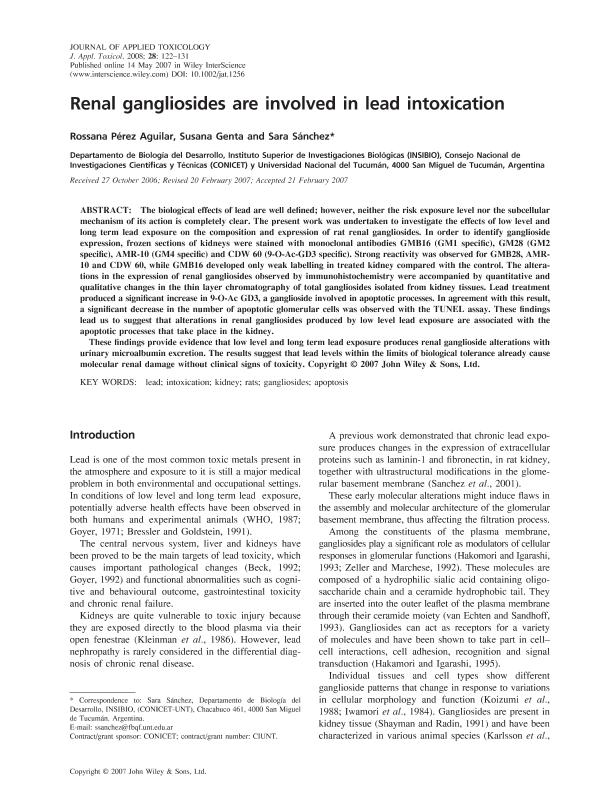Artículo
Renal gangliosides are involved in lead intoxication
Fecha de publicación:
03/2008
Editorial:
John Wiley & Sons Ltd
Revista:
Journal of Applied Toxicology
ISSN:
0260-437X
Idioma:
Inglés
Tipo de recurso:
Artículo publicado
Clasificación temática:
Resumen
The biological effects of lead are well defined; however, neither the risk exposure level nor the subcellular mechanism of its action is completely clear. The present work was undertaken to investigate the effects of low level and long term lead exposure on the composition and expression of rat renal gangliosides. In order to identify ganglioside expression, frozen sections of kidneys were stained with monoclonal antibodies GMB16 (GM1 specific), GM28 (GM2 specific), AMR-10 (GM4 specific) and CDW 60 (9-0-Ac-GD3 specific). Strong reactivity was observed for GMB28, AMR-10 and CDW 60, while GMB16 developed only weak labelling in treated kidney compared with the control. The alterations in the expression of renal gangliosides observed by immunohistochemistry were accompanied by quantitative and qualitative changes in the thin layer chromatography of total gangliosides isolated from kidney tissues. Lead treatment produced a significant increase in 9-O-Ac GD3, a ganglioside involved in apoptotic processes. In agreement with this result, a significant decrease in the number of apoptotic glomerular cells was observed with the TUNEL assay. These findings lead us to suggest that alterations in renal gangliosides produced by low level lead exposure are associated with the apoptotic processes that take place in the kidney. These findings provide evidence that low level and long term lead exposure produces renal ganglioside alterations with urinary microalbumin excretion. The results suggest that lead levels within the limits of biological tolerance already cause molecular renal damage without clinical signs of toxicity. Copyright © 2007 John Wiley & Sons, Ltd.
Palabras clave:
Apoptosis
,
Gangliosides
,
Intoxication
,
Kidney
,
Lead
,
Rats
Archivos asociados
Licencia
Identificadores
Colecciones
Articulos(INSIBIO)
Articulos de INST.SUP.DE INVEST.BIOLOGICAS
Articulos de INST.SUP.DE INVEST.BIOLOGICAS
Citación
Pérez Aguilar, Rossana Cristina; Genta, Susana Beatriz de Fátima; Sanchez, Sara Serafina del V.; Renal gangliosides are involved in lead intoxication; John Wiley & Sons Ltd; Journal of Applied Toxicology; 28; 2; 3-2008; 122-131
Compartir
Altmétricas




